An evolution of the CV-33
There were two main differences between the two models. The CV-35's armor was bolted rather than riveted, and the FIAT mod.14 8 mm (0.31 in) twin machine-gun mount was standard. These were later replaced by FIAT mod.34s or Breda mod.38s. There were also minor modifications between models, depending on the parts used and the manufacturer. This new model was mass-produced, and manys CV-33 (renamed L3/33 in 1938) were retrofitted alongside the L3/35 specifications. The L3/35 armor was also slightly heavier, but the vehicle had a more powerful FIAT SVA petrol engine, and the speed was almost unchanged. The twin mount was an ingenious system which made lateral and vertical aiming easy, but in the desert, sand dust tended to jam this mount. The upper part of the tracks was supported by Acacia wooden trails. A large encasing was placed just after the forward wheel to accommodate spare parts. The serie II was different only on minor details.Variants
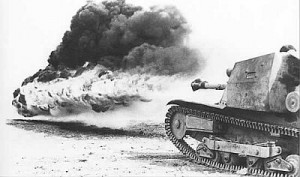
L3/35 Lanciaflame in action - Credits Comandsupremo.com
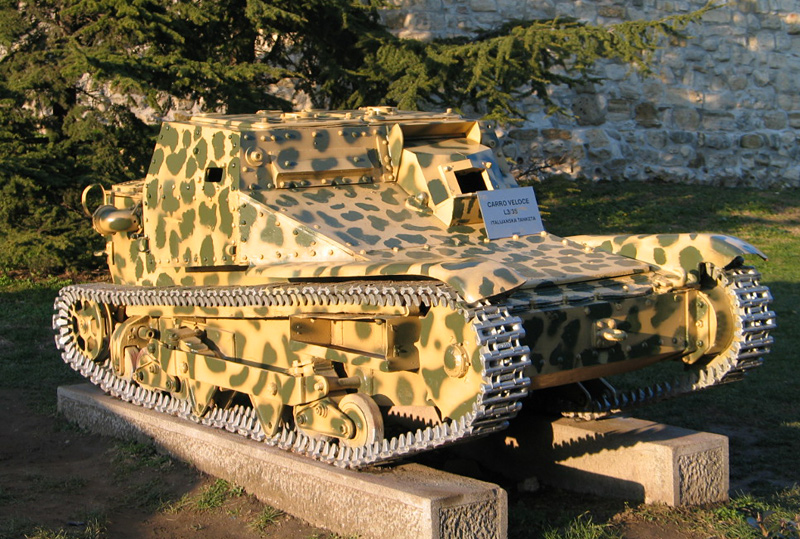
CV-35 at the Belgrade museum.
The overall limited size and power-to-weight ratio of this vehicle prevented extensive modifications, but several armaments were tested. First, a single Breda 13.2 mm (0.52 in) machine gun proved far more effective than the usual 7.9 mm (0.31 in) pair, and so did a twin mount with Madsen 13 mm (0.52 in). The latter was designed for export and sold to Brasil (23 units in total), and formed the base of the CV-38. A few Breda models (on serie L3/35 II) were seen in action, mostly in Sicily and Tunisia. There was also an aircraft carried version, the Aviotrasportabile. A few Controcarro based on the CV-35 were apparently also built. There were also several conversion prototypes, including the Semovente L3 da 47/32, a 47 mm gun carrier. Production was never launched.
Exports
The cheap CV-35 found success on the export market, and were six were sold to Albania, seventy-two to Austria and ten to Bulgaria (both with German Schwartzlose machine-guns). Hungary bought the licence to build a custom version with a Brno 26 machine-gun and a new turret hatch. All were used extensively by these Axis forces. A few were sold to the Greeks prior to the war, used against the Italians in 1940, and captured in 1941 by the Germans, who gave them back to the Italians. The Croats took delivery of nine CV-35s, forming part of the Presidential Guard Brigade and at least three tank companies (1st Brigade of Ustasha). By April 1944, two tank companies of the Croatian tank battalion were left with a mix of 22 CV-33/CV-35 and other vehicles. The Bolivian army acquired fourteen CV-35 serie II in 1938, which remained in service until the mid-1940s.The L3/35 in action
Another photo of the same.
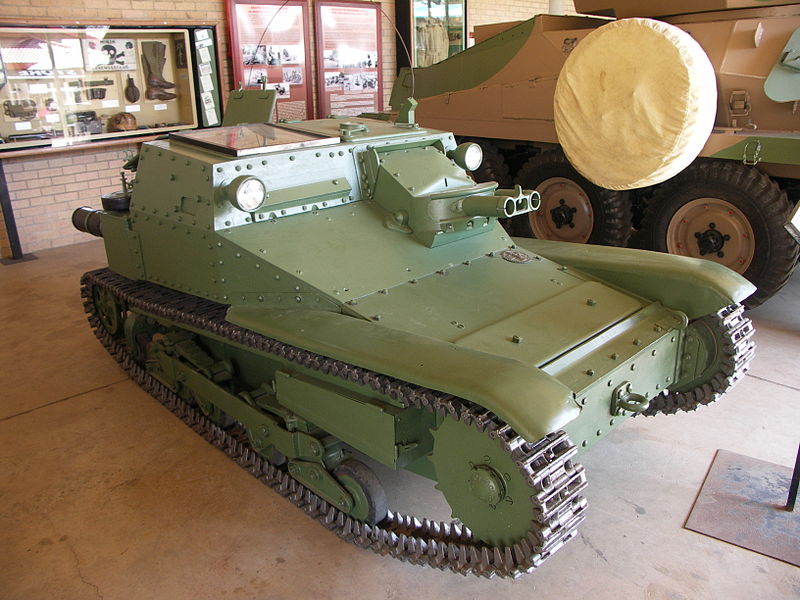
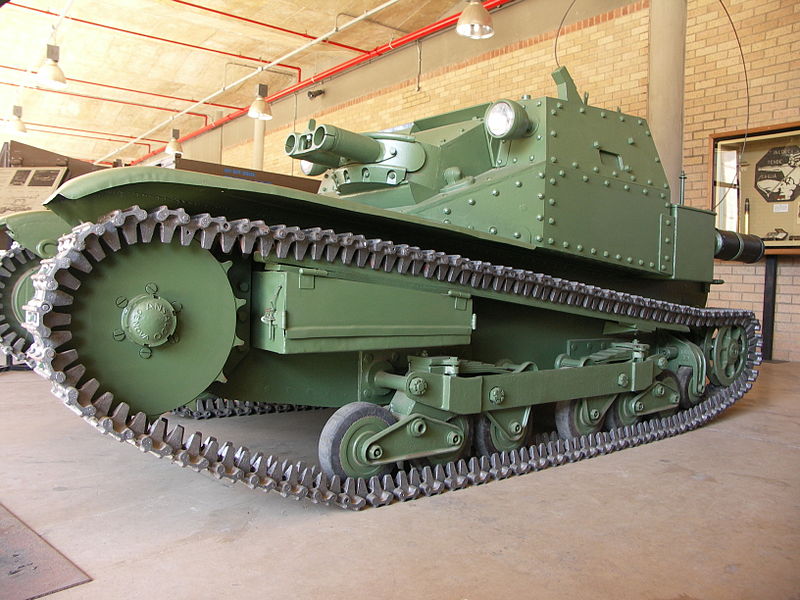
Carro Leggero L3/35
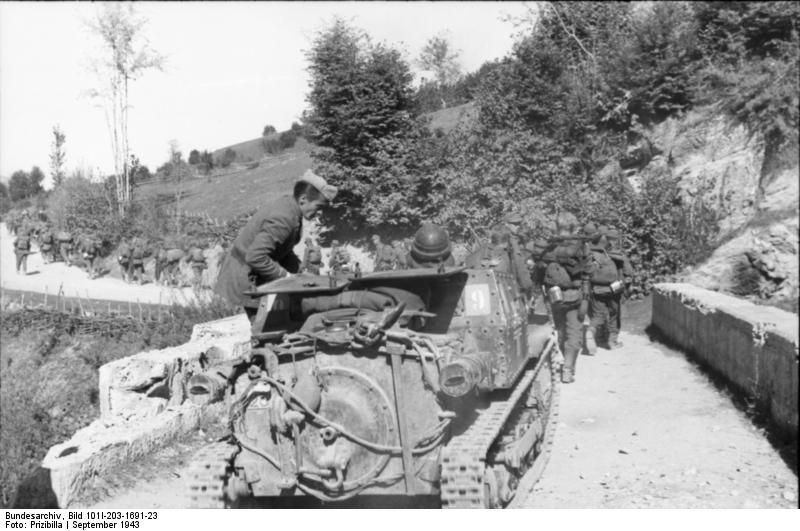
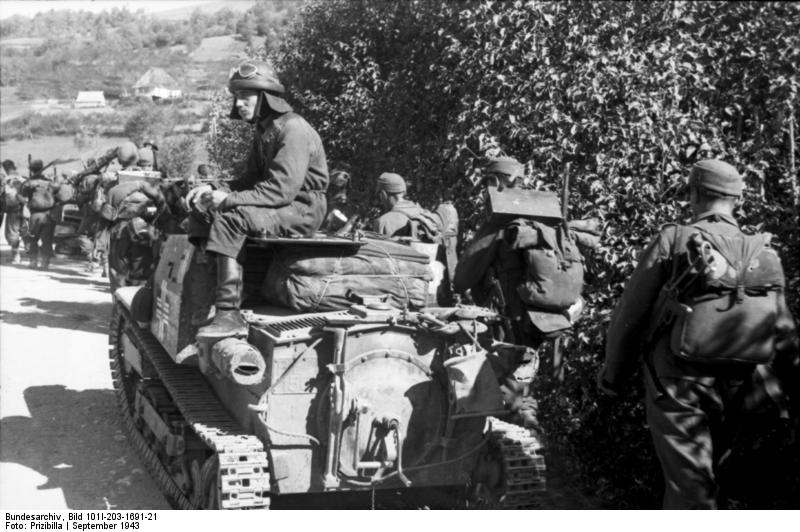
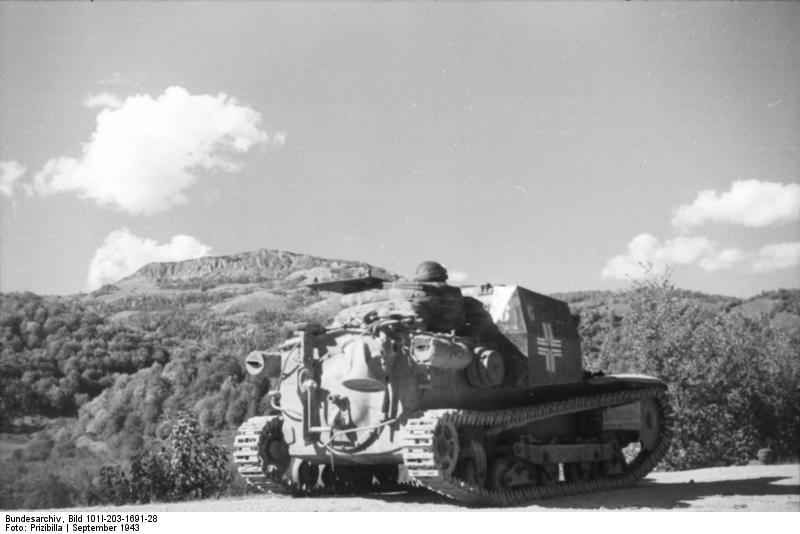
As of 1936 the Italian Army had 14 battalions armed with CV-33/CV-35s, including flamethrower modifications. For a long time they were regarded as infantry support tanks. Their shortcomings led to the 1934 program to construct of new types of vehicles, but the use of tankettes lasted until 1940.
Cavalry units were equipped with large numbers of CV-35s. In 1935 they entered service with the gruppi squadroni Carri Veloci named "San Giorgio", "San Marco" and "San Guisto". Each had 61 tankettes, part of the organizational structure of mobile divisions.
First blood was drawn in Ethiopia in late 1935, and later in Spain, as Mussolini decided (under the advice of Colonel Valentino Babini) to support nationalist forces with troops and some CV-35s. The first batch of five vehicles arrived August 16, 1936, and another of ten on 29 September. Spain also ordered seven more and three flamethrower CV-35lf. The first company was formed in September-October 1936, and paraded in front of Generalissimo Franco.
The Italian Expeditionary Force received 155 (157?) CV-35 and flamethrower versions between December 1936, 1937 and April 1938. A complete battalion (Battaglione Carri d\'Assalto) was operational in January 1937, put under the command of Captain Paladini. This unit was tried in October 21 on the road to Madrid. However, on the 29th of October they encountered a Republican T-26 model 1933, and four vehicles were lost in the action. Later on, they were found committed in Malaga, Guadalajara, and Satander in March 1937. On February 6, 1938, they performed well at Alhambra. They also did well in March-April 1938 in Aragon, and later on the Ebro river and in Catalonia. In the very last days of the war, an entire company, jam-packed in a street, was found, assaulted and defeated single-handedly by Republican Corporal Celestino Garcia Moreno, with grenades and a pickaxe. He disabled four, captured ten men, and the rest apparently fled. Tankettes also saw action until May 1939, loosing a total of 53 vehicles.
Tankettes were again deployed for the occupation of Albania in April 7-12, 1939. They were involved in the campaign for the "Horn of Africa", starting on June, 11, 1940. On the Sudanese border, CV-35s of the Squadrone Carri Veloci Cavalieri di Neghelli assisted the 4th Infantry Division. The whole 39 vehicle strength of the 1st and 2nd companies of the 3rd Tank Regiment was lost until early 1941.
In June 1940, the Italian army in Libya had seven tank battalions totaling 324 tankettes, mostly CV-35s. On June, 16, a first clash occurred with a British column, which ended with a total loss of 17 tankettes. Reports complained about the thin armor. At Sidi Barrani, the Italians provided 275 tanks, but of the L3 and M11/39 types. CV-35 tankettes were only present within M11/39 mixed companies, with no avail. Thrown against Matildas, the battalion was completely destroyed. In November 1940, and Italian special brigade massed some six battalions of CV-35/38s. Most could be later found at Tobruk, with only 11 vehicles left. The 32nd Tank Regiment, part of "Ariete" division, comprised some 117 L3s of late type, including 24 flamethrower versions. They did well, with help from the Afrika Korps in Cyrenaica in April 1941. Last mentions of their use came in November 1941, but most surviving vehicles were completely worn out by then.
In October 1940 the Italian Army had the 25th and 26th Army Corps ready to attack Greece through Albania, with 6 infantry divisions, 1 armored (Litorrio) and 1 of Alpini. The armored division totaled 163 tankettes (according to other sources 250, mostly CV-35s), but after initial success, they were pinned down by vigorous counter-attacks and a hard winter. The mountainous terrain meant the tankettes were found of limited use and took heavy losses with few gains. In August 1941, 55 L3s were transferred to the IIIth gruppo carri veloci "San Georgio", sent to the Eastern Front (Ukraine). More were lost due to the extreme conditions of weather and terrain, rathan due to enemy action, and in July 1942 the remainder were all sent back to Italy.
In early 1942, in Yugoslavia, the Italian occupation forces did counterinsurgency near Perusic, Licki Osik, Siroka Kula and around Ljubov in 22 January. Several CV-35s help helped to deter a partisan battalion, but the Yugoslavs staged an ambush the next day, claiming three of these tankettes. At Ljubov, other tankettes tried to take the village but were stopped by a barricade of stones, and two were damaged. The Yugoslav partisans managed to capture two CV-35s, and pressed them into service. In September, three more were captured and three more "donated" by the Croatian Army guerrillas. The situation was also deteriorating rapidly in Dalmatia, where the 1st and 2nd battalions of the 1st Tank Regiment were sent, fielding many tankettes. It was reinforced by a unit of flamethrower tankettes, and in August 1942, transferred to Montenegro with the 3rd Tank Battalion. 13 L3s participated in the operations in Rhodes in May 1941, and stayed there garrison for most of the war.
In November 1942, the former "San Marco" and IIIth gruppo "Piemonte Reale" were relocated to occupying the Cote d'Azur. The XIIIth battaglione carri was transferred to Sardinia, and then Sicily, in the fall of 1943. These were later repatriated for the survivors in Southern Italy. After the armistice, the majority of the surviving L3s were assigned to the RSI (Republica Soziale Italiana), under German control (CV-35 and CV-38 mostly), the "Leonessa", "Leoncello" and "San Guisto" operating against partisans. They were also briefly used by the Wehrmacht used for security purposes. The labor organization Todt was also given some for patrolling sensitive areas. Under German control, these were known as the Panzerkampfwagen CV35 731(i) and, until April 1945, fought against partisans and Allied forces.
The Hungarian L3/35
In 1934, the Hungarian government purchased large quantities of CV-33s. They modified some with a conning tower housing a 13.2 mm (0.52 in) Breda 38 machine gun, an automatic 20 mm (0.79 in) gun or a flamethrower. Others were rearmed with a Czech SPARK 7.92 mm (0.31 in) machine gun or Brno ZB vz.26/ZB vz.30. The transaction and delivery were held secret, and the armament and modifications were locally made. In August 1935, 30 modified CV-33s were delivered (designated 37M). The second batch arrived in 1936, with 121 CV-35 (38M). Seven new tank companies (18 CV-33 and CV-35 each) were distributed between the 1st, 2nd cavalry and 2nd motorized brigades. In April 1941, these took part in the Yugoslavian campaign, and after which they were deployed to guard and patrol the borders. However, in the summer of 1941, 65 Hungarian tankettes were sent to the Eastern Front, being part of the 1st Mobile Corps under the command of Major-General Bela Miklos Danloki, attached to the Army Group "Center" as two motorized and one cavalry brigades. They operated in Ukraine. Most were lost by December 1941, and the survivors sent to training units back home.Links
About the L3/35 on WikipediaL3/35 specifications |
|
| Dimensions (L-W-H) | 3.17 x 1.4 x 1.3 m (10.4x4.59x4.27 ft) |
| Total weight, battle ready | 3.2 tons |
| Crew | 2 (driver, machine-gunner) |
| Propulsion | Fiat SPA CV3, 6 cyl, 43 hp |
| Speed | 42 km/h (26 mph) |
| Range (road) | 125 km (78 mi) |
| Armament | 2x Breda 7.92 mm (0.31 in) machine-guns |
| Armor | From 6 to 12 mm (0.24-0.47 in) |
| Total production | Around 1,300 |
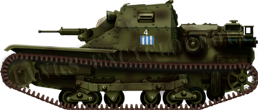
Carro Veloce CV-35 serie II, Ariete division, Libya, May 1941.
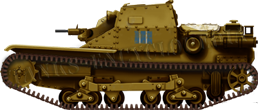
Carro Veloce CV-35 with the special twin Breda 13 mm (0.31 in) heavy machine-gun mount, Ariete division, Libya, March 1942.
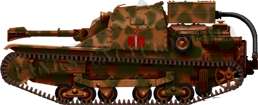
The LF version was the most produced of all L3/35 conversions. They were equipped either with a towed tank or carried one (as seen here) of napalm or alcohol mixed gasoline. They were used against fixed position in Africa, fighting at Tobruk, Gazala, El Alamein.
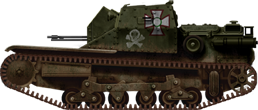
Hungarian Fiat-Ansaldo 35M from the 1st Reconnaissance Battalion in early 1941, still bearing the old national insignia.
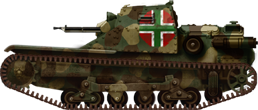
Fiat-Ansaldo 35M H241 from the 1st Hungarian Cavalry Battalion, Eastern front, summer 1941
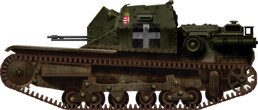
Fiat-Ansaldo 35M of the Hungarian Military Police in Galicia, 1944.

WW2 Tanks




























WW2 tanks posters

All Tiger tanks liveries.

Panther liveries and variants

WW2 Armour - All tanks











Tanks aces and single tanks series

Find more there

Museums, Movies, Books & Games
The Tanks and Armor in pop culture
Tanks and armored vehicles in general are only really grasped when seen first person: The mass, the scale, it's all there. Explore also the way tanks were covered in the movie industry, in books and in video games.Movies:
Best tanks movie on warhistoryonline.com
On imdb.com
On bestsimilar.com/
miltours.com
liveabout.com/
watchmojo.com
Video Games:
pcgamesn.com
historyhit.com
levvvel.com
vg247.com/best-tank-games
mmobomb.com/
alienwarearena.com

